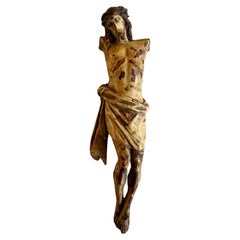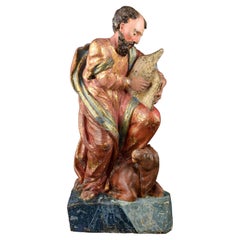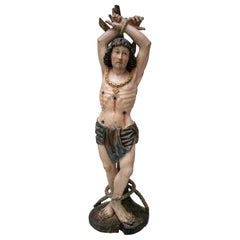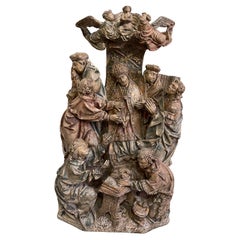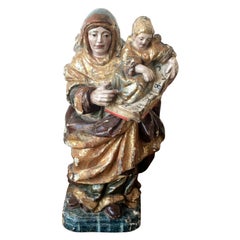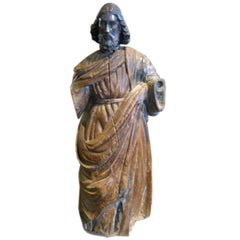16th Century Religious Items
to
9
69
11
80
4
711
721
707
25
281
277
89
24
14
31
29
19
97
9
25
8
8
47
43
18
11
8
68
25
13
8
7
80
80
80
1
1
Period: 16th Century
17th-Century Alpine Wooden Christ Torso with Polychrome Traces
Located in Hamburg, DE
17th-Century Alpine Wooden Christ Torso with Polychrome Traces
This finely carved wooden Christ torso, likely from the Alpine region and dating to the 17th century, is a remarkable p...
Category
Italian Baroque Antique 16th Century Religious Items
Materials
Wood
"Saint Luke the Evangelist", Polychromed Wood, 16th Century
Located in Madrid, ES
Saint Luke is often represented as a man of mature and bearded age, accompanied by the animal of the Tetramorphs with which he is related (Revelation 4: 67)...
Category
Spanish Renaissance Antique 16th Century Religious Items
Materials
Wood
16th Century German Hand Carved Painted Wood St. Sebastian
Located in Marbella, ES
16th century German hand carved painted wood St. Sebastian.
Category
German Antique 16th Century Religious Items
Materials
Wood
Early 16th Century Stone Carving - 'The Death of a Prelate'
Located in Basildon, GB
An Early 16th Century Stone Carving with polychrome : 'The Death of a Prelate'. The enthroned figure of a Bishop surrounded by attendants and surmounted by celestial angels.
Category
European Gothic Antique 16th Century Religious Items
Materials
Stone
16th Century Spanish Carved & Polychrome Painted Saint Anne with the Infant Mary
Located in Miami, FL
This sculpture represents Santa Ana (Saint Anne) with the infant Mary.
Verge.
Category
European Baroque Antique 16th Century Religious Items
Materials
Wood
$12,480 Sale Price
20% Off
18th Century Spanish Santos
Located in Dallas, TX
Hand carved Santos in original condition. Beautiful old patina.
Category
Spanish Antique 16th Century Religious Items
Materials
Wood
Limoges enamel plaque depicting Christ on te cold stone, France, mid-16th c.
Located in Gorssel, GE
An enamel plaque depicting Christ on the cold stone with two caretakers and tools of suffering, with inscription'”I.H.s. Salva tor Modi’,
France Mid-sixteenth century.
Dimensions: 1...
Category
French Antique 16th Century Religious Items
Materials
Copper, Enamel
Saint Anthony with the Child Jesus, Wood, Mechelen School, 16th Century
Located in Madrid, ES
Saint Anthony with the Child Jesus. Wood. Mechelen School, 16th century.
Sculpture in carved wood worked, as was usual in that center, on the front because it was designed to be pla...
Category
European Renaissance Antique 16th Century Religious Items
Materials
Other
Pair of 16th Century Iznik "Dome on the Rock" Ceramic Tiles
Located in Gloucestershire, GB
Pair of 16th Century Iznik "Dome on the Rock" ceramic tiles.
These tiles formed part of the ceramic tile pattern that covers the exterior of the base of the Dome Of The Rock shrine, ...
Category
Israeli Antique 16th Century Religious Items
Materials
Ceramic
Reliquary Pendant, Flagellation of Christ, Silver, Enamel, 16th Century
Located in Madrid, ES
On one side of the pendant, Christ appears tied to a tall column in the center of the composition, being whipped by two sayones or soldiers with branches, following a customary compo...
Category
European Renaissance Antique 16th Century Religious Items
Materials
Silver, Enamel, Other
Relief with angel head. Polychrome and gilded wood. Spanish school, 16th century
Located in Madrid, ES
Relief with angel head. Polychrome and gilded wood. Spanish school, 16th century.
Rectangular table that presents, on the front, a relief of certain depth and figurative theme. On a...
Category
Spanish Renaissance Antique 16th Century Religious Items
Materials
Other
Gilt Brass Alms Collecting Dish, Nuremberg, Germany, 16th Century
Located in Madrid, ES
Alms collection dish made of gilded brass decorated with a series of moldings and details both on the edge and towards the center. In this area there is a figurative motif in light r...
Category
German Renaissance Antique 16th Century Religious Items
Materials
Brass
Pax or Pax Board, Bronze, Spain, 16th Century
Located in Madrid, ES
Paper holder bronze, 16th century.
Portapaz made of bronze with an "asymmetric" handle on the back, which presents a decoration in light relief framed in an architectural compositio...
Category
European Renaissance Antique 16th Century Religious Items
Materials
Bronze
Saints Apostles John and Paul, Wood, Castillian School, 16th Century
Located in Madrid, ES
Pair of polychrome wood sculptures. "San Juan and San Pablo". Castilian school, 16th century.
Both male figures have been represented standing, with their main iconographic attrib...
Category
Spanish Renaissance Antique 16th Century Religious Items
Materials
Other
San Miguel Arcángel in Carved Wood, Polychrome, Stewed and Gold, Castilla FF SX
Located in Marbella, ES
San Miguel Arcángel in carved wood, polychrome, stewed and gold, castilla ff SX.
Category
Antique 16th Century Religious Items
Materials
Wood
16th Century Walnut Sculptures from Germany
Located in Brussels, Brussels
Very elegant sculpture reprenting a Putti (angel) from the German renaissance period -16 century
Rare sculpture in walnut of great quality with a very beau...
Category
German Renaissance Antique 16th Century Religious Items
Materials
Walnut
$4,253 Sale Price
20% Off
Possibly Saint Hubert or Saint Eustace, Wood, Spanish School, 16th Century
Located in Madrid, ES
Possibly Saint Hubertus or Saint Eustace. Carved, polychrome and gilded wood. Spanish school, 16th century.
Carving in polychrome and gilded wood, sim...
Category
Spanish Renaissance Antique 16th Century Religious Items
Materials
Wood
18th c. Spanish Santos
Located in Dallas, TX
Hand Carved Santos in original condition. Beautiful old Patina.
Category
Spanish Antique 16th Century Religious Items
Materials
Wood
$6,127
Silver Chrism Vessel or Chrismarium, No Original Lid, 16th Century
Located in Madrid, ES
Crismera Silver in its color. 16th century. Cover not original.
Silver chrome in color with a circular foot decorated with an engraved composition of vegetable elements and a flat circular body with two "ese" handles with vegetal motifs and a small neck at the top covered with a lid topped by a ring (which it is not the original of the piece). The body has engraved, on the one hand, a cross on a pedestal with a shroud hung from it, all within an engraved frame; On the other hand, with a frame similar to that mentioned, appear the letters "ihs" (cristogram of ancient origin, already used in the Early Christian, which gave rise to varied etymologies and was adopted as a seal by San Ignacio...
Category
European Renaissance Antique 16th Century Religious Items
Materials
Silver
Bronze Pax or Pax Board, 16th Century
Located in Madrid, ES
Paper holder bronze, 16th century.
Bronze paper holder with flat handle on the back that features a light relief decoration on the front. Under an auction of openwork elements of cle...
Category
Spanish Renaissance Antique 16th Century Religious Items
Materials
Bronze
Recently Viewed
View AllMore Ways To Browse
John Brown Bible
St Francis Of Assisi
Used Monstrance
Antique Quran
Jesus Healing
Reliquary Box
Russian Icon Mother Of God
Sacred Heart Of Jesus
Spanish Crucifix
Used Catholic Religious Statues
Antique Wood Rosary
Religious Altar Pieces
Religious Bas Relief
Sunburst Religious
Baroque Chalice
Pulpits Used
Russian Bronze Icon
Spanish Colonial Jesus
